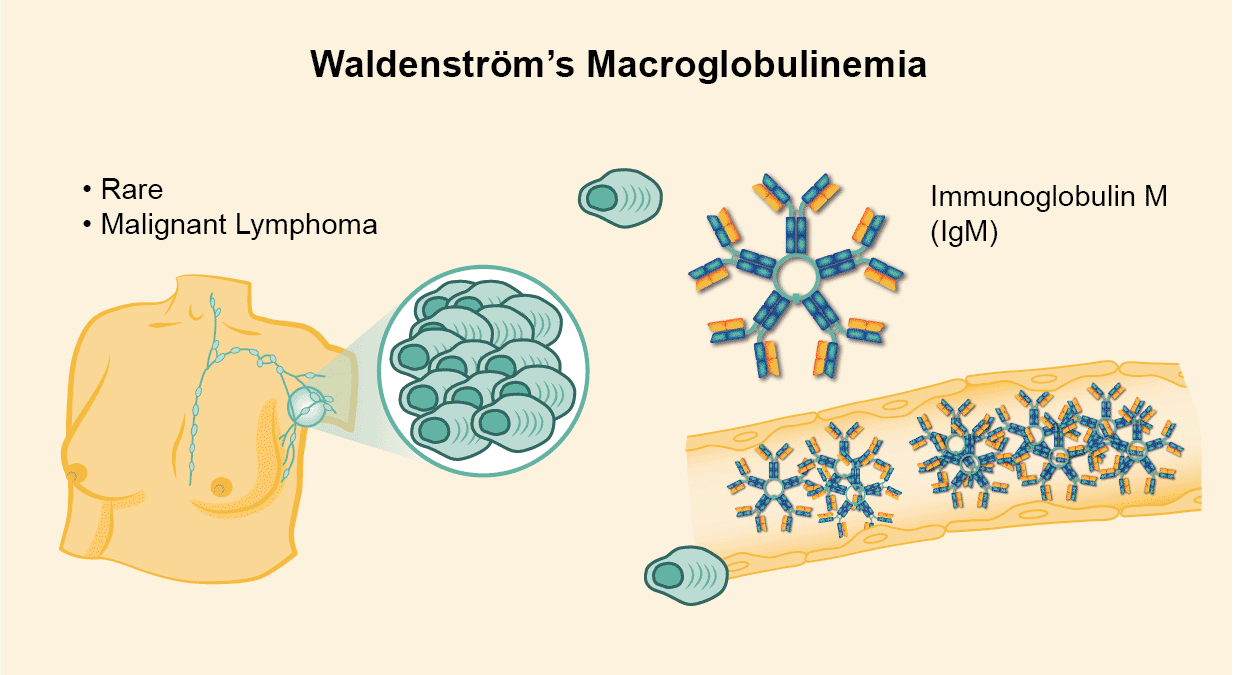Symptoms
Learn more about the symptoms of Waldenström’s macroglobulinemia.
Symptoms of Waldenström’s macroglobulinemia
In this section you can find out more about the symptoms of Waldenström’s macroglobulinemia, which may include1:
- Easy bruising
- Bleeding from the nose or gums
- Fatigue
- Weakness
- Shortness of breath
- Fever, night sweats
- Headache
- Unexplained weight loss
- Confusion
- Abdominal swelling and diarrhea
- Peripheral neuropathy (numbness, weakness or pain in the hands or feet)
- Changes in the color of the fingertips when exposed to cold
- Changes in vision (may include blurry vision or ‘double’ vision)
- Enlarged lymph nodes
- Infections
- Raised pink or flesh-colored lesions on the skin

From severe fatigue to enlarged lymph nodes: Waldenström's macroglobulinemia patients show a variety of symptoms that can indicate the first signs of the disease to a physician.
»At least 25% of patients are asymptomatic at diagnosis.«2
Morel P and Merlini G. Expert Rev Hematol. 2012.
Clinical manifestations of Waldenström's macroglobulinemia
Clinical manifestations of Waldenström macroglobulinemia include hepatomegaly (20%), splenomegaly (15%), and lymphadenopathy (15%).3 The pathological outcomes in WM are due to bone marrow infiltration by small lymphocytes and IgM monoclonal gammopathy.1 Neurological and visual symptoms result from hyperviscosity and reduced blood flow, whilst bleeding often results from IgM binding to clotting factors.1 Cryoglobulinemia can lead to cold urticaria and Raynaud syndrome.1 Some studies have shown an association between the hepatitis C virus, autoimmune disorders and WM.1,4 Familial predisposition is reported in up to 20% of cases, and these patients generally present at an earlier age and with a greater degree of bone marrow involvement.1
Plasma cell differentiation underlies many of the symptoms and clinical features of Waldenström's macroglobulinemia
In this excerpt from the BeiGene satellite symposium at EHA 20205, Dr. Roger Owen discusses how plasma cell differentiation underlies many of the clinical features of Waldenström's macroglobulinemia.
Dr. Owen reviews the notion of plasma cell differentiation, whereby B-cells differentiate into plasma cells, and how this process is central to much of the biology and many of the clinical features observed in Waldenström's macroglobulinemia.6 The extent to which this differentiation occurs varies from patient to patient, and it is this process, rather than disease bulk perse, that is likely to determine the level of IgM.6,7 In the majority of patients, CD20-expressing, cell division capable B-cells predominate, and are likely to be responsible for the bulk-type symptoms such as anemia, constitutional symptoms and adenopathy.6
Dr. Owen discusses how the plasma cell component (which can be a minor component in some patients and a very dominant component in others) will be terminally differentiated, will lack CD20 expression, and will generally be incapable of cell division. He explains that these cells are responsible for IgM secretion, and may be a more rational component for consideration when looking at paraprotein-related phenomena such as hyperviscosity, neuropathy and cold agglutinin disease (CAD).6,7




